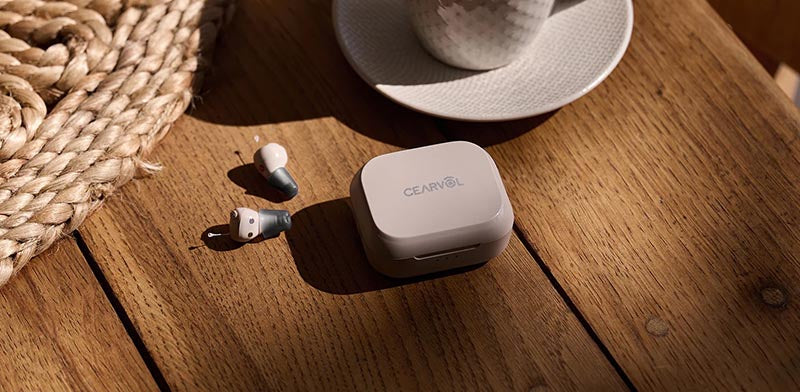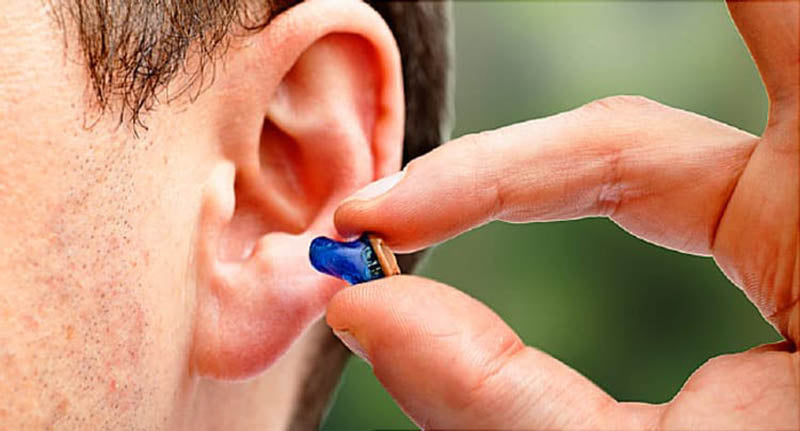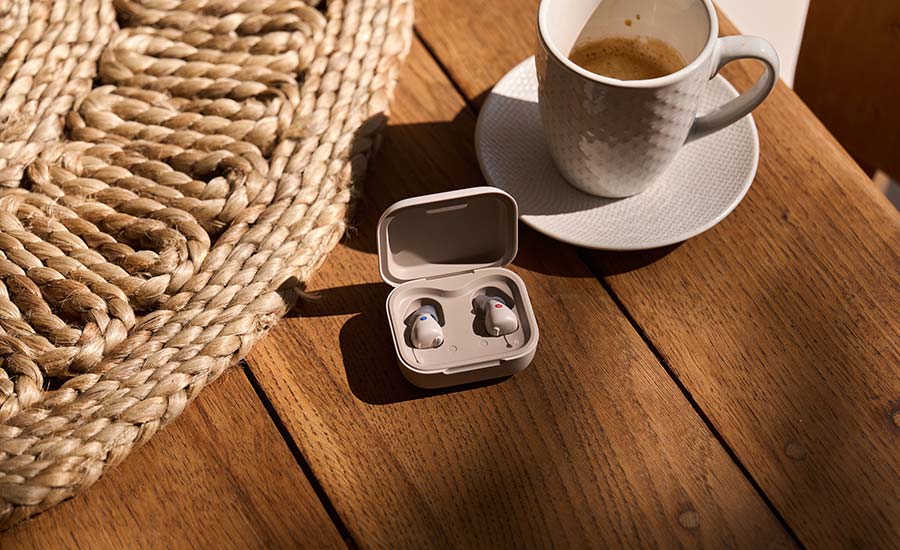While hearing aids are built to restore clearer sound, the stigma surrounding bulky or highly visible devices can sometimes undermine confidence in social or professional settings. However, with a discreet design, small hearing aids provide the same benefits without the awkwardness. So what are small hearing aids? This guide explores why they matter, the basic types like ITE, CIC, and ITC, how they suit different needs, pricing, and value in 2025, and top models to consider. Don't miss out!
🚀 Navigate This Post
You may also be interested in:
- Cool, Practically Invisible and Stylish Hearing Aids: Meet the New Era of Hearing Aids
- 7 Best Invisible Hearing Aids of 2025: Bluetooth, OTC & Tinnitus-Friendly Picks
- [New] Best Affordable Hearing Aids with Bluetooth in 2025
Part 1: Why Choose Small Hearing Aids?
Small hearing aids excel in both discretion and practicality. That's why they are a preferred choice for individuals seeking effective hearing support without drawing attention to visible devices. Positioned securely inside the ear, they utilize the ear's natural contours to enhance sound collection, reduce wind interference, and deliver more natural audio.
The benefits of small hearing aids are obvious: cosmetic appeal. They are nearly invisible to combat stigma, and many offer comfort for all-day wear. With no external tubes or wires, small hearing aids are easier to use with telephones, headphones, and helmets. Meanwhile, some models are being partly shielded by the ear's outer structure, so there is a very low risk from bumps or snags.

Small hearing aids, generally, are great for active users, glasses wearers, or people who need an invisible hearing solution. Their discreet size and lightweight fit make them comfortable for extended wear and less likely to interfere with everyday activities. However, small dimensions can limit battery capacity, meaning shorter operating times compared to larger models.
Part 2: Types of Small Hearing Aids
“Small” is a broad category. So, what are we exactly talking about when we talk about small hearing aids? Here are the most common types:
In-The-Ear (ITE) Hearing Aids: Custom-molded to fill the outer ear, ITE hearing aids work well for mild to severe hearing loss. They provide a comfortable fit with room for larger batteries, manual controls, and even Bluetooth connectivity. The trade-offs are slight visibility and a higher risk of earwax buildup. They are an excellent choice for people with dexterity issues.
Completely-In-The-Canal (CIC) Hearing Aids: CIC hearing aids sit deep inside the ear canal and are almost invisible, perfect for those who value aesthetics. Designed for mild to moderate loss, CIC usually offers a discreet appearance, natural sound, and sometimes Bluetooth streaming (depends on model). Downsides are also obvious: shorter battery life, more delicate handling, and greater moisture exposure.

In-The-Canal (ITC) Hearing Aids: Positioned partly in the canal and partly in the outer ear, ITC hearing aids strike a balance between size and functionality for mild to severe loss. Even with a discreet design, they offer app controls, noise cancellation, and other advanced features. Some potential drawbacks are: dexterity challenges and increased earwax exposure.
Invisible-In-The-Canal (IIC) Hearing Aids: IIC devices are ultra-small variants that fit fully inside the canal. So they are completely hidden from view. Because of their tiny size, features are more limited. Not all ear shapes or hearing loss levels are suitable for IIC models. You will need to select based on ear anatomy, severity of loss, and professional guidance from an audiologist.
Part 3: Small Hearing Aids for Different Needs
As you can see, different small hearing aids adapt to different users. Your gender, age, and lifestyle also influence which style works best. Here's a closer look:
Small Hearing Aids for Women: Women often prioritize appearance, invisibility, and fashion; they seek devices that blend seamlessly with hairstyles, makeup, or accessories without drawing attention. Completely-in-the-Canal (CIC) or Invisible-in-the-Canal (IIC) devices are ideal, as they sit deep in the ear for maximum concealment while maintaining natural sound. These aids provide discreet fits, customizable colors, and sometimes water-resistant features for daily activities such as workouts or social events.
Small Hearing Aids for Men: Men typically focus on performance, noise reduction, and Bluetooth functionality. These features perfectly handle environments like offices, sports, or outdoor activities. In-The-Canal (ITC) or In-The-Ear (ITE) models fit well here, offering space for advanced tech without sacrificing discretion. Some of them even support directional microphones and app integration for customization.

Small Hearing Aids for Seniors: Seniors prefer simple, user-friendly designs without complex app controls. That makes them prioritize ease of handling for those with dexterity challenges or limited tech familiarity. In-The-Ear (ITE) models are recommended from the types; their larger size makes them easier to insert and remove. Some of them have larger buttons, automatic adjustments, and longer battery life, which reduces maintenance hassles.
Small Hearing Aids for Children: For children, small hearing aids must emphasize durability, safety, and adaptability to growing ears. While behind-the-ear styles are common for kids, small in-ear options work for mild loss. In-The-Canal (ITC) or In-The-Ear (ITE) are suitable recommendations, as they can be custom-molded and refitted as the child grows.
Part 4: Small Hearing Aids Prices and Value
In 2025, prices for small hearing aids depend on whether they are over-the-counter (OTC) or prescription models. Factors like technology level, brand, and customization also apply. According to the market data, here's a breakdown of small hearing aids prices.
| Type | OTC Price Range (per pair) | Prescription Price Range (per pair) | Key Features at Mid-Range Price |
|---|---|---|---|
| In-The-Ear (ITE) | $300–$1,000 | $1,000–$6,000 | Custom fit, Bluetooth, noise reduction |
| In-The-Canal (ITC) | $200–$800 | $1,200–$4,500 | Discreet partial canal fit, app control; mid-range includes AI noise cancellation |
| Completely-In-The-Canal (CIC) / Invisible-In-The-Canal (IIC) | $199–$700 | $3,000–$5,000+ | Ultra-discreet, deep fit, rechargeable batteries |
Additional Costs to Consider:
- Batteries: $50-$100 annually for non-rechargeable models.
- Maintenance and Cleaning: $100-$200 per year, including professional cleanings or accessories like drying kits.
- Warranties/Repairs: Extended coverage adds $100-$300; OTC often has 1-year warranties, prescription up to 3 years.
Part 5: Recommended Small Hearing Aids from Cearvol
If you have read this far, you might be wondering: Which small hearing aids should you go with? Here are two standout models from Cearvol.
Cearvol Nano:
The Cearvol Nano is a discreet OTC ITC-style hearing aid for mild to moderate loss with a compact design that sits partially in the ear canal. It includes a smart charging case with physical buttons for effortless mode switching, delivering clear audio and comfort for everyday use without a professional setup.
Key features:
- Discreet fit partially in the ear canal for natural sound capture and reduced visibility.
- Innovative charging case with physical buttons to easily switch modes without an app.
- WDRC technology to ensure superior clarity and dynamic range for varied environments.
- Feedback suppression to eliminate annoying whistling during calls or close interactions.
- Up to 16 hours of continuous use per charge, with the charging case to deliver a total of up to 54 hours of listening time.
- UV sanitizing case to eliminate up to 99.9% of bacteria, keeping your hearing aids hygienic and safe.
Who is it best for: Beginners or those who prioritize invisibility and simplicity in daily routines; seniors with mild to moderate hearing challenges want to avoid complex tech.
Cearvol Wave Lite:
The Cearvol Wave Lite is an ITE OTC hearing aid blending style and advanced tech, with a textile shell for subtle elegance. The small in-the-ear hearing aids offer 40dB gain for mild to moderately severe loss, AI noise reduction, and versatile connectivity, ensuring clear, comfortable hearing in diverse settings.
Key features:
- Up to 40dB gain with 24-channel WDRC for powerful, balanced amplification across frequencies.
- Cearvol AI 2.0 intelligently reduces background noise for focused conversations in crowds.
- Bluetooth and AUX-IN ports enable seamless streaming from phones, TVs, or other devices.
- Intuitive mobile app for fine-tuning volume, modes, and custom sound profiles.
- Up to 22 hours with the included charging case; a quick 15-minute charge for 3 hours of use.
- IPX5 water-resistant suits active lifestyles without compromising performance.
Who is it best for: Tech-savvy adults with moderate loss, professionals, or seniors who need noise management and seamless connectivity.






コメントを書く
全てのコメントは、掲載前にモデレートされます
このサイトはhCaptchaによって保護されており、hCaptchaプライバシーポリシーおよび利用規約が適用されます。